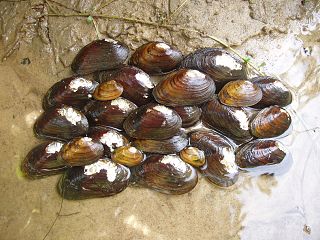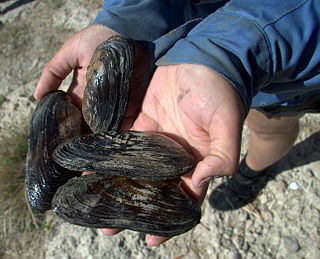
The northern riffleshell is a subspecies of freshwater mussel, an aquatic bivalve mollusk in the family Unionidae, the river mussels. This mussel is endangered and federally protected. It was proposed as a species, Epioblasma rangiana, by Williams et al. (2017).

The yellow bullhead is a species of bullhead catfish, a ray-finned fish that lacks scales.

Anodontoides is a genus of freshwater mussels, an aquatic bivalve mollusk in the family Unionidae, the river mussels.
Elliptio mcmichaeli, the fluted elephantear, is a species of freshwater mussel, an aquatic bivalve mollusk in the family Unionidae, the river mussels.

Epioblasma flexuosa, the arcuate pearly mussel or leafshell, was a species of freshwater mussel, an aquatic bivalve mollusk in the family Unionidae, the river mussels. This species was endemic to the United States, where it was found in the major drainages of the Ohio River, including the Cumberland, Tennessee, and Wabash Rivers. Its natural habitat was flowing water.

Epioblasma stewardsonii, the Cumberland leafshell or Steward's pearly mussel, is an extinct species of freshwater mussel in the family Unionidae.

Fusconaia cuneolus, the fine-rayed pigtoe pearly mussel or fine-rayed pigtoe, is a species of bivalve in the family Unionidae. It is native to Tennessee, Alabama, and Virginia in the United States, in each of which its population has declined severely. It is a federally listed endangered species of the United States.

Lampsilis bracteata, also known as the Texas fatmucket, is a species of freshwater mussel in the family Unionidae, the river mussels. This species is endemic to the tributaries of the Colorado River within the Edwards Plateau region in Texas, the United States. Populations from the upper Guadalupe River basin are now assigned to a distinct species, Lampsilis bergmanni. The two species are morphologically indistinguishable but genetically distinct.
The green floater is a species of freshwater mussel, an aquatic bivalve mollusk in the family Unionidae, the river mussels.

Atlanticoncha ochracea, the tidewater mucket, is a species of freshwater mussel, an aquatic bivalve mollusc in the family Unionidae, the river mussels. Formerly classified in the now-defunct genus Leptodea, it is now considered the only member of the monotypic genus Atlanticoncha.

The Louisiana pearlshell, Margaritifera hembeli, is a rare species of bivalve mollusk in the family Margaritiferidae. This freshwater mussel is native to Louisiana in the United States, and was previously present also in Arkansas. It grows to a length of about 10 cm (4 in) and lives on the sand or gravel stream-bed in riffles and fast flowing stretches of small streams. Its life cycle involves a stage where it lives parasitically inside a fish. This mollusk is sensitive to increased sedimentation and cannot tolerate impoundments. Because of its limited range and its population decline, the International Union for Conservation of Nature has rated this mollusk as being "critically endangered".

The James River spinymussel, also known as the Virginia spinymussel, is a species of freshwater mussel in the family Unionidae, the river mussels. This species is native to North Carolina, Virginia, and West Virginia in the United States. It is a federally listed endangered species of the United States. It was formerly placed in Pleurobema but in 2017, Perkins, Johnson & Gangloff placed the species into a new genus Parvaspina on account of genetic data and its lateral spines.

Popenaias popeii, common name the Texas hornshell, is a species of freshwater mussel, an aquatic bivalve mollusk in the family Unionidae, the river mussels.

Theliderma intermedia, the Cumberland monkeyface pearly mussel or Cumberland monkeyface, is a species of freshwater mussel in the family Unionidae, the river mussels. This aquatic bivalve mollusk is native to Tennessee and Virginia in the United States. Historically widespread in the upper Tennessee River system, it populations have been reduced by habitat destruction and pollution. It now only occurs in two tributaries: the Duck and Powell Rivers. It is a federally listed endangered species.

Toxolasma cylindrellus, the pale lilliput naiad, pale lilliput pearly mussel, or pale lilliput, is a species of freshwater mussel, an aquatic bivalve mollusk in the family Unionidae, the river mussels. Its host is the northern studfish.
The golden pebblesnail, scientific name Somatogyrus aureus, is a species of minute freshwater snails with an operculum, aquatic gastropod molluscs or micromolluscs in the family Lithoglyphidae. This species is endemic to Alabama and Tennessee in the United States. Its natural habitat is the Tennessee River system, with the type locality being given as the Holston River.

Potamilus fragilis, previously Leptodea fragilis, the fragile papershell, is a species of freshwater mussel, an aquatic bivalve mollusk in the family Unionidae, the river mussels. P. fragilis is one of the fastest-growing unionid species and the most abundant unionid species in Lake Erie. Its light-shelled morphology suggests an adaptation to deep water within lakes.

Epioblasma obliquata, commonly called the catspaw, is a species of freshwater mussel. It is native to eastern North America, where it is classified as endangered under the Endangered Species Act. There are two subspecies, each with distinct morphology. Due to species rarity, the behavior of this organism is unknown beyond general freshwater mussel behavior.

Ambleminae is a subfamily of freshwater mussel in the family Unionidae. They are found throughout much of eastern North America south to Central America, although fossils are also known from Siberia. Some species have also been introduced to East Asia. They are the most speciose radiation of the Unionidae, with more than 300 species.

Parvaspina is a genus of freshwater mussels, aquatic bivalve mollusks in the family Unionidae. It contains only two critically endangered species, both endemic to river basins in a small region of the southeastern United States.


















